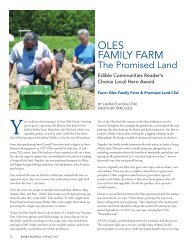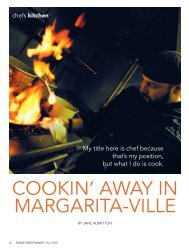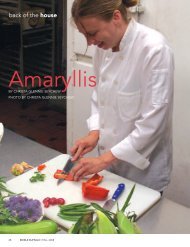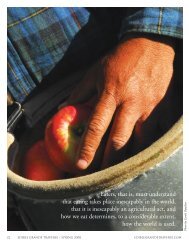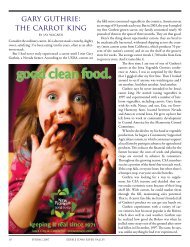WILL SUNBATHE FOR FOOD - Edible Communities
WILL SUNBATHE FOR FOOD - Edible Communities
WILL SUNBATHE FOR FOOD - Edible Communities
Create successful ePaper yourself
Turn your PDF publications into a flip-book with our unique Google optimized e-Paper software.
<strong>WILL</strong> <strong>SUNBATHE</strong><br />
<strong>FOR</strong> <strong>FOOD</strong><br />
by sarah inez levy<br />
Photographs by Cheryl Koehler<br />
It’s one of those perfect summer afternoons in Orinda when<br />
there’s not a cloud in the sky and you can’t hear the groaning<br />
motors of Highway 24 above the birdsong. I’m sitting on Wendy<br />
Helms’s back porch eating lunch. She’s served a lovely garden salad<br />
with avocados and homemade honey mustard dressing. The honey<br />
came from Wendy’s own bees, which I can see buzzing around at<br />
the other end of the yard. There are also juicy bits of chicken and<br />
a tender cracked-wheat salad, both of which we pulled from her<br />
solar oven only minutes ago. Now, we’re sunning our toes in the<br />
very rays that cooked the food on our plates.<br />
“It’s amazing!” I exclaim, through a mouthful of helio-chicken.<br />
“No,” Wendy corrects me, “it’s not amazing. It’s actually quite<br />
simple.” She’s right, of course. There’s nothing incredible about using<br />
the sun’s energy to cook our food. What’s shocking is that I’ve<br />
never done it before.<br />
Let’s back up an hour: Wendy is delicately placing chicken<br />
breast pieces on the bottom of a black cooking pot. She dabs each<br />
morsel with a spoonful of apricot-chili jam (a homemade gift from<br />
a friend) and covers the pot. She explains that the chicken needs<br />
no oil; unlike a conventional oven, the slow cooking of the solar<br />
Wendy’s beehives are kept company here by a weed she refered to as “wild artichoke.”<br />
Corn muffins working on a tan.<br />
oven locks in moisture, resulting in tender meat that never sticks.<br />
Wendy then fills a second pot with cracked wheat, sunflower<br />
seeds, and parsley and covers this with boiling water—a shortcut,<br />
she admits.<br />
The “Sport” Solar Oven into which we’re about to place our<br />
lunch was produced by the nonprofit Solar Oven Society (SOS).<br />
It’s made from the plastic of 68 recycled soda bottles<br />
and the entire thing weighs only 10 pounds.<br />
It seems somewhat out of place on Wendy’s tasteful<br />
deck, looking like a cross between an amplifier<br />
and a television set. My solar chef dons a pair of<br />
new silicone oven mitts and places the two pots<br />
inside the preheated oven. She takes note of the<br />
oven’s shadow to aim the oven properly toward<br />
the sun and places reflectors around the top for extra<br />
heat. Then, through the simple laws of physics,<br />
the insulated solar oven and dark enamel pots absorb<br />
energy from rays of the sun streaming down<br />
through the blue Orinda sky, heating the inside of<br />
the chamber to nearly 300 degrees. Now we need<br />
only relax and wait.<br />
Wendy thanks a spike in environmental consciousness<br />
for better-than-ever solar oven sales<br />
this year. She volunteers as a local distributor for<br />
the SOS, spreading the word on solar cooking and<br />
demonstrating the Sport at local farmers’ markets.<br />
She sees first-hand the extent to which the SOS<br />
has benefited from consumers’ growing interest<br />
in leading greener lives and buying eco-products.<br />
www.edibleeastbay.com EDIBLE EAST BAY FALL 2007 45
However, despite all the fun that I’m having watching the sun<br />
work its magic on my lunch, it’s hard to believe that this contraption<br />
will really catch on. It’s easy enough to use here, on a sunny<br />
day in California when we are happy to wait for our meal, but<br />
what about gray winter days in the Northeast when dinner needs<br />
to be on the table in 20 minutes?<br />
Wendy seems to have read my mind and clarifies that the SOS<br />
does the greatest ecological and social good abroad, where the<br />
Sport Solar Oven eases deforestation and improves quality of life<br />
for people with limited access to cooking fuel. In many developing<br />
countries, I learn, millions of people are forced to spend excessively<br />
on fuel or travel unsafe distances to collect scarce firewood.<br />
Many of these people also suffer the negative health effects of indoor<br />
cooking fires and contaminated drinking water. Meanwhile,<br />
steady deforestation for fuel exacerbates both social and environmental<br />
problems.<br />
The Solar Oven Society is hoping to alleviate the situation by<br />
using solar oven sales in America to subsidize the cost of placing<br />
Sport ovens in developing countries. The society organizes solar<br />
cooker demonstrations and trainings in villages from Afghanistan<br />
to Zambia, teaching local people how to use the ovens for cooking<br />
and water pasteurization and introducing them to alternative<br />
fuel-saving technologies. But, as Wendy says, you don’t have to go<br />
to Africa to make a difference. She did go once on holiday, packing<br />
a Sport oven into an extra suitcase to spare SOS the shipping<br />
cost. But for the rest of us, buying a solar oven and showing it off<br />
to friends is no less constructive.<br />
It’s time to check on the chicken, so Wendy once again slips on<br />
her silicone mitts and lifts the lid off the oven. Then she raises the<br />
dark pot cover to reveal a dozen ivory lumps of chicken lounging<br />
in their own lightly perfumed juices. I lean in closer for a good<br />
sniff. There’s something very pure about cooking like this, and<br />
even though I’m one to enjoy the satisfaction of lovingly stirring<br />
a risotto or fussing over a complex cassoulet, I appreciate how the<br />
leisurely, unhurried process of cooking in this oven has influenced<br />
my perspective on the whole afternoon. As the food emerges soft<br />
and tender, it seems as though we have received a gift from the<br />
heavens, and as I take the first bite of my Sport-cooked chicken,<br />
I feel like I’m eating a bit of sunshine. Knowing that we’ve used<br />
almost no fuel makes it taste even better.<br />
Of course, people have long experimented with solar cooking,<br />
and the SOS Sport is by no means the only solar oven on the market.<br />
In fact, a quick googling reveals a surprisingly large selection<br />
of cookers, one cardboard and boxy, another made of metallic<br />
panels in the shape of a satellite dish. Many solar oven manufacturers<br />
support environmental and humanitarian efforts in developing<br />
countries, so choosing the best one for your backyard could<br />
be daunting.<br />
Cooks Illustrated recently evaluated three solar ovens (the SOS<br />
Sport among them) on the roof of its test kitchen in the Boston<br />
46 FALL 2007 EDIBLE EAST BAY www.edibleeastbay.com
suburbs. After testing everything from potatoes to marinated pork<br />
to chocolate chip cookies, the team declared the Sport their solar<br />
favorite. It proved the least sensitive to temperature fluctuations,<br />
large enough to hold a baking sheet, easy to clean, and reasonably<br />
priced. Their recommendation came with a caveat, though: Potential<br />
buyers should be aware that while solar cooking—with any<br />
oven—can be enjoyable, it requires some trial and error and much<br />
flexibility. I’m guessing that we won’t be rushing to replace our<br />
conventional ovens or barbecue grills with solar ovens for quite a<br />
while, but in the meantime, solar cooking is an entertaining way<br />
to introduce environmentally sensitive options into our fuel-sucking<br />
kitchens—or rather, outside of them.<br />
As I savor the meal, seasoning each mouthful with breaths of<br />
fresh garden air, I’m thinking about all the places one could tote<br />
the Sport oven for a hot meal on the go. The possibilities scroll<br />
through my mind like a Dr. Seuss rhyme: Would you, could you<br />
on a boat? Could you, would you at the beach? At your campsite?<br />
Strapped to your alligator pool raft? Then I start having visions<br />
of the Kitchen of the Future: solar-powered oven and fridge, bicycle-powered<br />
mixer, zero waste . . . The environmentalist in me is<br />
painting my daydreams green.<br />
All of a sudden, my plate is empty. (Apparently slow food<br />
doesn’t always beget slow eating.) Wendy has pulled out a binder<br />
of solar oven recipes and is pointing out her favorites. As I browse<br />
through the listings for roasted vegetables, fish stews, and “quick”<br />
breads, the sun toasts the skin on my forearm and I wonder if dedicated<br />
solar cooks begin to measure their days in meals: 30 minutes<br />
spent mowing the lawn = crisp-tender asparagus; two hours at a<br />
soccer match = one pot of chili; one full work day = a pot roast.<br />
It’s probably not a bad way to perceive the world.<br />
The sun is moving steadily across the backyard, slanting the oven’s<br />
shadow off to one side. Resisting the urge to re-aim the oven<br />
and fill the pot with another delicious experiment, I help Wendy<br />
bring the dirty plates into the house. I’m happy to be in a kitchen<br />
solar sirloin tips<br />
1 ½ pounds sirloin tips (or sirloin steak), cut into 1-inch<br />
pieces<br />
1 pound fresh mushrooms, sliced<br />
1 medium-sized onion, cut in wedges<br />
1 clove garlic, minced<br />
Place sirloin tips in bottom of solar oven pot. Do not add<br />
any oil. Sprinkle garlic over the meat and then add sliced onion<br />
and mushrooms on top of sirloin tips. Place pot in solar<br />
oven to cook. It should take about 2 hours.<br />
solar chicken breasts<br />
2 boneless, skinless chicken breasts<br />
1 tablespoon capers<br />
1 chopped, fresh tomato<br />
Several garlic chives, chopped<br />
Place chicken brests in bottom of solar oven pot. Spread capers,<br />
tomatoes and garlic chives over top. Place pot in solar<br />
oven. It should take about an hour and a half.<br />
Recipes Courtesy of Solar Oven Society<br />
again, surrounded by familiar comforts, pleasant memory associations,<br />
and—not least important—a dishwasher. But then, as my<br />
eyes slowly adjust to the indoor dimness, the once-normal kitchen<br />
begins to look terribly elaborate, full of switches and burners and<br />
buzzing appliances. I’m already feeling nostalgic for the clever<br />
simplicity of the Sport oven.<br />
On the drive home (30 minutes = cooked zucchini), I let my<br />
newfound solar optimism muffle the harsh, dirty reality of the<br />
thousands of cars whooshing around me. I’m welcomed home by<br />
the wafting perfume of a bowl of ripe peaches, but though I’m dying<br />
to bake them into a summertime pie, I wait until sundown to<br />
preheat the oven. Maybe it doesn’t make much of a difference to<br />
the grid, but for today, out of new respect for the sun, it’s the least<br />
I can do. •<br />
The SOS Sport Solar Oven is available for $150 from<br />
www.solarovens.org.<br />
Writer Sarah Inez Levy once ate a Pop-Tart outside Chez Panisse.<br />
Except for this one lapse in judgement, she has enjoyed a steady love<br />
affair with the edible treasures of the Bay Area. Sarah is a Boston native<br />
and freelance writer with a gift for spotting wild blackberries.<br />
www.edibleeastbay.com EDIBLE EAST BAY FALL 2007 47



